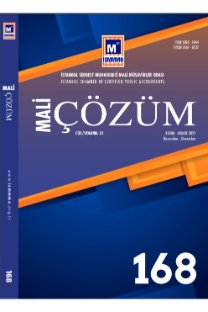VERGİDEN KAÇINMAK KOLAY MI?
IS IT EASY TO AVOID TAX?
___
- Badertscher, B. A., Katz, S. P., and Rego, S. O. (2013). “The separation of ownership and control and corporate tax avoidance” Journal of Accounting and Economics, 56(2), 228-250.
- Cai, H., and Liu, Q. (2009). “Competition and corporate tax avoidance: Evidence from Chinese industrial firms” The Economic Journal, 119(537), 764-795.
- Chan, K. H., Mo, P. L.L., and Zhou, A. Y. (2013). “Government ownership, corporate governance and tax aggressiveness: Evidence from China.” Accounting & Finance, 53(4), 1029-1051.
- Chan, K.H., Mo, P.L.L., and Tang, T. (2016). Tax avoidance and tunneling: Empirical analysis from an agency perspective, 15(3), 49-66.
- Chen, S., Chen, X., Cheng, Q., and Shevlin, T. (2010). “Are family firms more tax aggressive than non-family firms?” Journal of Financial Economics, 95(1), 41-61.
- Clausing, K.A. (2003) “Tax-motivated transfer pricing and US intrafirm trade prices” Journal of Public Economics, 87, 2207-2223.
- Contractor, F.J. (2016) “Tax avoidance by multinational companies: Methods, policies and ethics” Rutger Business Review, 1(1), 27-43.
- Desai, M. A. (2003). “The divergence between book income and tax income” Tax policy and the economy, 17, 169-206.
- Desai, M. A., & Dharmapala, D. (2006). “Corporate tax avoidance and high-powered incentives” Journal of Financial Economics, 79(1), 145-179.
- Demirgüç-Kunt, A., and Huizinga, H. (2001). “The taxation of domestic and foreign banking” Journal of Public Economics, 79(3), 429-453.
- Dyreng, S., Hanlon, M., Maydew, E. (2008). “Long-run corporate tax avoidance” The Accounting Review, 83.61-82.
- Egger, P., Eggert, W.,and Winner, H. (2010). “Saving taxes through foreign plant ownership” Journal of International Economics, 81(1), 99-108.
- Earnst & Young (2016). Global transfer pricing survey.
- Fuest, C. & Riedel, N. (2009). Tax evasion, tax avoidance and tax expenditures in develoing countries: A review of the literature. Report prepared for the UK Department for International Development. Oxford: Oxford University Centre for Business and Taxation.
- Gaertner, F. B. (2014). “CEO after‐tax compensation incentives and corporate tax avoidance” Contemporary Accounting Research, 31(4), 1077-1102.
- Gelir İdaresi Başkanlığı (2010). Transfer fiyatlandırması yoluyla örtülü kazanç dağıtımı hakkında rehber
- Gündüz, Z. (2005). “Türkiye’de vergi nasıl kaçırılıyor?”, Mali Çözüm, 73, 24-35.
- Hanlon, M. and Heitzman, S. (2010). “A review of tax research” Journal of Accounting and Economic, 50, 127-178.
- Hanlon, M., and Shevlin, T. (2005). “Book-tax conformity for corporate income: An introduction to the issues” Tax Policy and the Economy, 19, 101- 134.
- Hess, M.F. and Alexander, R.M. (2015) “Brewing up controversy: A case exploring the ethics of corporate tax planning.” Issues in Accounting Education, 30(4), 311-327.
- Kaygusuz, S.Y. ve Dokur, Ş. (2005). “Transfer fiyatlama yöntemlerinin değerlendirilmesi ve faaliyet tabanlı transfer fiyatlama modeli”. İktisadi ve İdari Bilimler Dergisi, 19(2), 407-425.
- Kim, C., and Zhang, L. (2016). “Corporate political connections and tax aggressiveness” Contemporary Accounting Research, 33(1), 78-114.
- Kinney, M., and Lawrence, J. (2000). An analysis of the relative US tax burden of US corporations having substantial foreign ownership. National Tax Journal, 9-22.
- Landry, S., Deslandes, M., and Fortin, A. (2013). Tax aggressiveness, corporate social responsibility, and ownership structure. Journal of Accounting, Ethics & Public Policy, 14(3), 611-645.
- Liu L, Schmidt-Eisenlohr, T. and Guo, D. (2017). International transfer pricing and tax avoidance: Evidence from linked trade-tax statistics in the UK. International Finance Discussion Paper, 1-39.
- Mahenthiran, S., and Kasipillai, J. (2012). Influence of ownership structure and corporate governance on effective tax rates and tax planning: Malaysian evidence. Austl. Tax F., 27, 941.
- Manzon Jr, G. B., & Plesko, G. A. (2001). The relation between financial and tax reporting measures of income. Tax L. Rev., 55, 175.
- Nar, M. (2015). “Vergi Planlaması aracı olarak Ar-Ge harcamaları.” Uluslararası Sosyal Araştırmalar Dergisi, 37(8), 925-940.
- Needham, C. (2013). Corporate tax avoidance by multinational firms. Library Briefing;Library of European Parliament, 1-5.
- Otusanya, O.J. (2011) “The role of multinational companies in tax evasion and tax avoidance: The case of Nigeria.” Critical Perspectives on Accounting, 22, 316-332.
- Phillips, J. D. (2003). “Corporate tax-planning effectiveness: The role of compensation-based incentives” The Accounting Review, 78(3), 847-874.
- Rego, S. O. (2003). “Taxavoidance activities of US multinational corporations” Contemporary Accounting Research, 20(4), 805-833.
- Riedel, N. (2014). Quantifying International Tax Avoidance: A review of the academic literature. ETPF Policy Paper 2.
- Shevlin, T. (2001). Corporate tax shelters and book-tax differences. Tax L. Rev., 55, 427.
- Shi, S. (2017). “Coping with the increasingly stringent global anti-tax avoidance environment: The case of MNCs in China” International Tax Journal, 43(1), 27-36.
- Taylor, G. and Richardson, G. (2012) “International corporate tax avoidance practices: Evidence from Australian firms” International Journal of Accounting. 47, 469-496.
- T.C. Yasalar (21.06.2006). 5520 sayılı Kurumlar Vergisi Kanunu. Ankara : Resmi Gazete (26205 sayılı)
- ISSN: 1303-5444
- Yayın Aralığı: 6
- Başlangıç: 1991
- Yayıncı: İstanbul Serbest Muhasebeci Mali Müşavirler Odası
Mehpare KARAHAN GÖKMEN, Hümeyra ADIGÜZEL
FİNANSAL GÖSTERGELERDEKİ DEĞİŞİMİN BIST100 TRENDLERİNE ETKİLERİ
TÜRK İŞ HUKUKUNDA ÇAĞRI ÜZERİNE ÇALIŞMA: UYGULAMADA KARŞILAŞILAN SORUNLAR VE ÇÖZÜM ÖNERİLERİ
MEHMET SABRİ TOPAK, Mustafa ÇANAKÇIOĞLU
DİĞER ÜCRETLİ HİZMET ERBABININ 2019 YILINDA ELDE EDECEĞİ ÜCRET GELİRLERİNİN VERGİLENDİRİLMESİ
